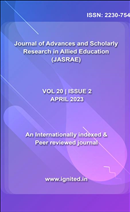Comparative Analysis of Labour Codes with Existing Legislation
A Comparative Study of Labour Codes and Existing Legislation in India
Keywords:
Comparative Analysis, Labour Codes, Existing Legislation, Indian Constitution, Parliament, State Legislatures, Central Labour Laws, Industrial Relations, Wages, Social SecurityAbstract
The term labour is included in the concurrent list of our Indian Constitution under 7th schedule.Hence, the law regulating labour can be enacted by both the Parliament and the State Legislatures. InIndia, labour is regulated through almost 40 central labour laws which regulate the various aspects oflabour such as social security, working conditions, wages and Industrial disputes. The existing labourlegislation is very complex and is very difficult to understand by people for whom this act has beenenacted. Hence to ease the complexities and to make uniformity in labour laws, the Second NationalCommission recommended to merge these labour laws into various categories such as IndustrialRelations, Wages, Social Security, Safety, and Welfare Working Conditions to make Indian Economymore vibrant and competitive.Accordingly, the Central Government had introduced four bills on labourcodes to consolidate the 29 major Centra labour laws out of 40 central labour laws.This paper highlights the major changes and its impact on regulation of law as we all know that now 14Central Acts with almost 1458 sections and 937 compliance's have been consolidated into four codeswith just 480 sections. After implementation of these codes, the industries will have an ease over filingmultiple returns under various labour laws. It will certainly decrease the working complexities of theCompany. Over the years, India has performed poorly in the ―Ease of Doing Business Index‖ reportpublished by the World Bank. Hence, the goal of the Indian Government behind introducing andimplementing labour codes is to make India a lucrative market hub for manufacturing industries. TheIndian Government has been trying hard in this direction since 2014. Undoubtedly, the businessenvironment in the country is improving rapidly and this happens due to continuous efforts of thepresent government which has prioritised this matter after 2014. As a result, India‘s Doing Businessranking has improved from a position of 142 in 2014 to 63 in 2022, as per the World Bank report. Andwith the completion of long pending labour reforms the government certainly achieved the goal to makeIndia in the top ten nations in the Ease of Doing Business index in the coming years.But, as we know every coin has two sides. It is true that on one hand, the codes will simplify the existinglaws, on the other hand these codes have loopholes too. Hence, the paper generally focuses to deal withthe various aspects of labour codes in comparison to existing labour laws for better understanding oflabour legislation because without comparison between the two, codes are not possible to understand.Downloads
Download data is not yet available.
Published
2023-04-08
Issue
Section
Articles
How to Cite
[1]
“Comparative Analysis of Labour Codes with Existing Legislation: A Comparative Study of Labour Codes and Existing Legislation in India”, JASRAE, vol. 20, no. 2, pp. 222–227, Apr. 2023, Accessed: Jan. 10, 2026. [Online]. Available: https://ignited.in/index.php/jasrae/article/view/14372











